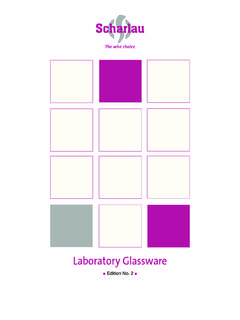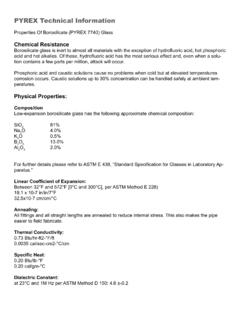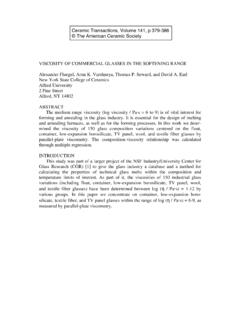Transcription of Surface Tension and Fusion Properties of Porcelain …
1 1 Surface Tension and Fusion Properties of Porcelain Enamels Charles Baldwin, Sid Feldman Ferro Corporation Proceedings of the Porcelain Enamel Instirute Technical Forum, Vol. 69, pages 1-10 (2007) Copyright: Wiley & Sons Co. (2007) Reprinted with permission of John Wiley & Sons, Inc. Please note: No rights are granted to use content that appears in the work with credit to another source Abstract High-temperature viscosity of glasses is an important key to understanding the phenomena that occur when firing Porcelain enamels. Porcelain Enamels Porcelain enamel is a glass coating fused to metal. While there are similarities between the spray application of enamels and paints, there are important differences because of the vitreous nature of Porcelain .
2 Porcelain enamel glass frit is typically alkali borosilicate where the alkalis are lithium, sodium, or potassium. Alkaline-earth ions such as calcium, strontium, or barium are also often present as fluxes. For adhesion, cobalt, nickel, iron, and copper are added to the glass . During smelting, the molten glass is quenched, which results in an amorphous molecular structure. glass does not have a distinct melting point, which is a sudden transition from a solid to liquid phase, but instead has a glass temperature (Tg) at which the solid glass becomes a highly viscous supercooled liquid. As the temperature is increased above Tg, the viscosity drops.
3 glass Viscosity Viscosity is resistance of a fluid to deformation. For a glass , the viscosity varies with temperature according to the Vogel-Fulcher-Tamman (VFT) equation1: log (n) = A + B/(T-T0) This is equivalent to the Williams-Landel-Ferry (WLF) model for viscosity of a polymer above its glass temperature, but neither model is used in the enameling industry. Typically, the enamel industry has interpreted glass viscosity according to the type of generalized diagram in Figure 1. On the chart, the borosilicate and soda-lime glass pass through the various points on the viscosity scale at lower temperatures than the nearly pure silica glasses.
4 The curve for Porcelain enamel alkali borosilicate glasses would be expected to be lower and to the left of the one for borosilicate glass . 2 Figure 1. glass viscosity versus temperature2 Firing Enamels It is most straightforward to consider the processes, which occur during firing of a ground coated part. First, the dried enamel and steel expand according to the respective thermal expansion ( ) of each. As such, the value of , Tg, and dilatometric softening point (Ts) of three ground coats was measured with an Orton Model 1000R dilatometer. Samples bars for thermal expansion measurements were prepared by placing 8 g of glass frit powder into a carbon mold.
5 The mold was fired at 1550 F (621 C) for 12 min. Next, the glass bar was placed into a 1000 F (538 C) furnace, which was switched off and allowed to cool overnight. Then, the bar was cut to a length of 2 inches ( 5 mm), and the edges were rounded on a grinding wheel. The sample was placed in a quartz tube in contact with a ceramic pushrod. As the temperature was increased from room temperature, a linear voltage displacement transducer (LVDT) measured the expansion of the bar. When the temperature was reached that the bar viscosity was low enough to start contracting under the force of the pushrod, the dilatometer automatically shut off shortly after a preset amount of contraction.
6 That temperature is the Ts. The thermal expansion curves are shown in Figure 2. The theoretical linear curve for enameling steel based on = x 10-6/ C is included for reference. The value of was determined by calculating the slope of the linear portion of the curve below 662 F (350 C) and is marked accordingly. 3 Figure 2. Measured thermal expansion of the three ground coat frits While a number of sophisticated tests exist to measure glass viscosity versus temperature,3 the Fusion flow test is used by the enamel industry to determine relative glass viscosity at a fixed temperature. Two grams of -10/+30 M frit powder were pressed into a pellet, which was placed along a line on the top edge of a ground coated bent panel.
7 The panel was put into a furnace at 1500 F (816 C) for min and then tilted up. The Fusion flow, f, is: f = xsample xref where xsample is the distance from a line parallel to the top edge of the panel that the test sample flowed, and xref is the distance run by the reference standard. The Fusion flow is negative if the test sample runs a shorter distance than the standard. The results are given in Table 1 with the values of , Tg, and Ts. glass (x 10-6/ C) Tg ( C) Ts ( C) Fusion Flow (816 C) Soft 407 457 +170 Medium 456 504 -6 Hard 536 594 -25 Table 1. Thermal expansion and viscosity results Enamel Wetting on Oxidized Steel As the metal temperature increases during firing, the reactions occur that create adhesion of the enamel to the steel.
8 Additionally, good spreading of the liquid enamel on the steel is a basic requirement for adhesion. The balance of forces arising from a drop of liquid enamel (l) on Surface (s) under a vapor (v) is schematically shown in Figure 3. 4 Figure 3. Liquid droplet on a solid surface4 Young s equation describes the balance of forces: where is the energy per unit area of the appropriate interface and is the contact angle between the liquid and the substrate. If s/v > s/l, the Surface will be wetted to decrease the area of the higher energy s/v interface; this is the preferred situation. If s/v < s/l, balling up of the liquid will occur to reduce the area of the higher energy s/l interface.
9 With typical enamel firing temperature between 1400 to 1600 F (760 to 871 F), the reactivity of the steel affects the wetting, and high-temperature reactive wetting remains relatively poorly In fact, the liquid enamel is not in contact steel, but actually with iron oxide that forms after firing begins. K. Sarrazy showed this by firing an enamel (with = x 10-6/ C, Tg = 475 C (887 F), and Ts = 545 C (1013 F)) on steel under argon and air as part of a study of adhesion. The appearance of the panels is shown in Figure 4. Since the iron oxide did not form under argon, s/v < s/l, the enamel could not wet the steel, and adhesion would not be possible.
10 Figure 4. Clear enamel after firing at 1472 F (800 C) under argon (top) and air (bottom)6 5 The Surface Tension of the soft, medium, and hard frits was estimated by calculating a weighted average of the oxide components and is shown in Table 2. It suggests that the soft frit will actually wet the substrate the least, and this was observed on the Fusion test. The flow on the soft frit was narrower and at a greater contact angle than the medium frit. Frit Surface Tension (Dynes/cm) Soft Medium Hard Table 2. Estimated Surface Tension Figure 5 shows the viscosity is a more important factor than the Surface Tension .






